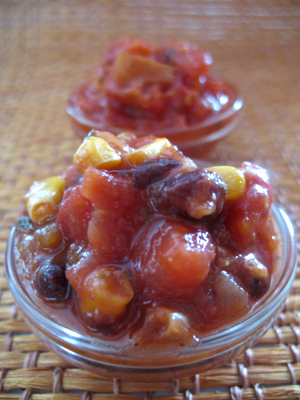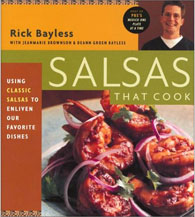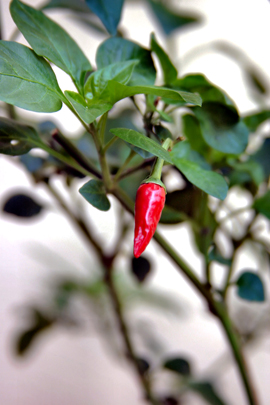 |


Salsa Bobos is laden with large chunks of tomato, black beans and kernels of corn. Behind it, Cowpoke Artichoke Salsa. Photo by Melody Lan. |
| WHAT IT IS: Gourmet salsas. |
| WHY IT’S DIFFERENT: Twenty-three different flavors, mostly tomato-based, each truly different from the rest. |
| WHY WE LOVE IT: Top-quality ingredients and mouth-watering recipes. Plus, the wide range of choices means that no matter how much you love salsa, you’ll equally love the anticipation of discovering something new. |
| PURCHASE AT: JardineFoods.com. |
|
|
 |

Jardine’s Gourmet Salsa:
Salsa To Dance About
CAPSULE REPORT: In 2000, salsa replaced ketchup as America’s number one condiment. Unlike a decent brownie, there’s perfectly acceptable salsa to be found in many supermarkets, and certainly in any specialty food store. So why make it a point to seek out D.L. Jardine’s “Special Edition” Salsas?
Like any good specialty food manufacturer, Jardine’s takes a basic product and makes it that much better. They use superior ingredients, more imaginative recipes (23 of them!), and a perspective that takes salsa from a condiment to a true sauce—even a side dish. We could eat most varieties straight from the bottle—no chips or chicken needed. There’s excitement in sweet and smoky Pineapple Chipotle Salsa, Salsa Bobos (“confetti”) so thick with beans and corn it could be served as a vegetable, and Cowpoke Artichoke Salsa with mushrooms, olives and balsamic vinegar. We’ve tasted so many lines of salsa that we’ve lost count. Jardine’s is one that towers above its competidores. There are nice gift samplers if you feel like sharing.
- To read the full review below, click here. If your e-mail client does not support anchor links that jump to text above or below, e.g. AOL, please scroll down.
- Read more reviews of our favorite salsas.
- Review the table of contents of the September issue of THE NIBBLE online magazine, plus the back issues archive and our most popular articles.
- All of the Top Pick Of The Week newsletters are permanently archived on TheNibble.com, in chronological order and by product category.
|
Salsa Recipes Galore
 |
|
|
Salsas That Cook: Using Classic
Salsas To Enliven Our Favorite
Dishes, by Rick Bayless. The Iron
Chef shows how salsa adds oomph to pasta, zest to meats, passion to potatoes and vitality to vegetables. Six salsas (which can be made or bought via mail order) are used in more than 50 recipes, including a tortilla lasagna and a fiery tequila chaser. Click here for more information or to purchase. |
The Great Salsa Book, by Mark Miller. The chef of the famed Coyote Cafe in Santa Fe provides 100 recipes, ranking the salsas
0-to-10 on a mild-to-hot scale. Ingredients range from the traditional to the exotic. Each recipe includes fairly simple cooking instructions, serving suggestions and variations. Click here for more information or to purchase. |
Chips, Dips & Salsas, by Judy Hille
Walker and Kim Maceachern. A
delightful collection of
easy-to-make and fun-to-eat chip, dip and salsa recipes. Creative, tasty, and popular snacks with variations to control the level of heat are guaranteed to make you an even more popular host/hostess. Click here for more information or to purchase. |
Salsa To Dance About: D.L. Jardine’s “Special Edition” Salsas
INDEX OF REVIEW
|
MORE TO DISCOVER |
Today there’s scarcely a town in America where one can’t buy salsa. By the turn of the century, salsa had become America’s number-one condiment, surpassing ketchup in sales.[1] But it took a while to get there. While salsa has been in the U.S. since the 1800s, this food of the ancient Mayas and Aztecs (who also gave us chocolate) was largely confined to Mexican communities in Texas, California and the Southwest.
Two big breakthroughs helped to push salsa to numero uno. The first, in 1947, was the introduction of bottled Picante Sauce, invented by Texan Dave Pace. His puréed version of fresh salsa, promoted as a way to add Texas-style flavor to everything from eggs to chicken, moved salsa from Mexican to mainstream, and was embraced by Americans eager to spice up their food. The second breakthrough was a dual phenomenon 20 years later: the beginning of the health food movement, initiated by hippies in search of better foods, and a country hungry for international cuisines. Mexican, along with Asian and Indian foods, were increasingly available due to a relaxed immigration law and the newcomers who wanted the foods of their homeland (plus fellow newcomers who were setting up stores and restaurants to offer them).
[1] According to ACNielsen data published in Progressive Grocer last year, total supermarket sales of ketchup in 2004 were $456.7 million, while Mexican sauces topped out at $895.8 million. Because this number reflects supermarket sales only and excludes club stores, convenience stores, dollar stores, online sales and specialty food stores, the number could exceed $1 billion (with a correspondingly higher figure for ketchup as well).

A jalapeño growing. A jalapeño is a chile. Chile pepper
is a misnomer. The word “pepper” was appended by
Christopher Columbus, who equated the fieriness of
the chile to the peppercorn he knew.
Chiles are not
related to peppercorns.
|
Salsa, the Spanish word for sauce, is a condiment. Its purpose is to perk up foods by providing flavor and heat. Unlike its rival ketchup, which seems to seek a common denominator flavor from manufacturer to manufacturer, there is a wide variation in salsas. In Mexico there are countless recipes, both by region and establishment (and household).
The typical Mexican salsa is a salsa verde, or green salsa, generally tart and with a high degree of chile heat. Bowls of it are placed on tables as commonly as salt and pepper in the U.S. It’s a purée of chiles, tomatillos and a blend of spices called ricado. Every establishment has its own ricado blend and every region has its own blend of chiles and degree of heat.
Tomato-based salsas—known as salsa roja or red salsa—are preferred in the U.S. and are more common in the north of Mexico. They are sweeter, and because of the types of chiles and seasonings used, smoky and spicier, in contrast to the tart salsa verde.
Other countries in Latin America have completely different recipes for salsa that are neither tomatillo nor tomato-based. Argentina’s chimichurri sauce, e.g., has a base of oil, vinegar and parsley. You can read more about the many different types of salsa in the Salsa Glossary below. |
Continue To Page 2: Types Of Mexican Salsa
Go To The Article Index Above
FOR ADDITIONAL INFORMATION, special offers,
contests, opinion surveys, THE NIBBLE prior issues archive, product gift-finder and more,
visit the home page of TheNibble.com.
Do you have friends who would enjoy THE NIBBLE?
Click here to send them an invitation to sign up for their own copy.
|
ABOUT THE NIBBLE. THE NIBBLE™, Great Finds For Foodies™, is an online magazine about specialty foods and the gourmet life. It is the only consumer publication and website that focuses on reviewing the best specialty foods and beverages, in every category. The magazine also covers tabletop items, gourmet housewares, and other areas of interest to people who love fine food.
© Copyright 2004-2025 Lifestyle Direct, Inc. All rights
reserved. All information contained herein is subject to change at any time
without notice. All details must be directly confirmed with manufacturers, service
establishments and other third parties. The material in this newsletter may not
be reproduced, distributed, transmitted, cached, or otherwise used, except with
the prior written permission of Lifestyle Direct, Inc.
|
 |
|
 |